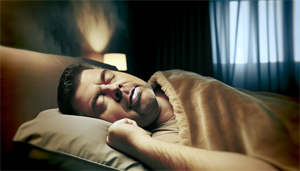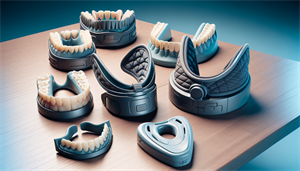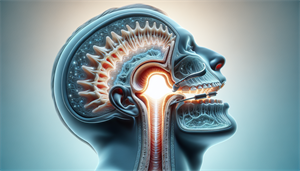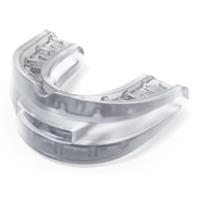Struggling with snoring and its impact on your sleep and daily life? Discover the power of an anti-snoring mouthpiece, a simple and non-invasive solution to transform your nights.
Dive into our comprehensive Snore Mouthpiece Guide to find the perfect fit for you and embark on a journey towards peaceful, restful sleep.
Key Takeaways
-
Snoring can significantly impact sleep quality, leading to fatigue and mood fluctuations, and may increase the risk of accidents; anti-snoring mouthpieces like SnoreRx Plus can help reduce snoring by keeping the airway open during sleep.
-
Mandibular advancement devices (MADs) and tongue-retaining devices (TRDs) are the two main types of anti-snoring mouthpieces, each working differently to prevent airway obstruction, with features such as adjustability and boil-and-bite customization enhancing their effectiveness.
-
It’s essential to select the right mouthpiece based on comfort, adjustability, and effectiveness, considering individual factors such as dentures or jaw pain; professional advice should be sought, especially for conditions like obstructive sleep apnea, which requires a specialized approach.
Understanding Snoring and Its Impact on Sleep

Snoring, an all too familiar nocturnal nuisance, is often the byproduct of compromised airflow through the respiratory passages. Factors such as:
-
a thick or elongated soft palate
-
persistent congestion
-
excessive body weight
-
pre-sleep alcohol consumption
-
fatigue
-
sleeping position
can make breathing more difficult, leading to the distinctive sound of snoring. But beyond being a mere annoyance, did you know that snoring can have adverse effects on your sleep quality?
That’s right, snoring can result in sleep disturbances, daytime drowsiness, fatigue, mood fluctuations, irritable behavior, and a reduced ability to concentrate. That’s not all—snoring can also elevate the risk of accidents and affect the sleep of not just the snorer, but their partner too. Sounds alarming, doesn’t it? Well, the good news is that with the right anti-snoring mouthpiece, like the highly recommended SnoreRx Plus, you can significantly reduce snoring and its effects.
Before exploring the realm of anti-snoring mouthpieces, a clear understanding of the distinction between ordinary snoring and the more severe condition, obstructive sleep apnea, is necessary. While snoring is typically caused by a partial obstruction of the airway, obstructive sleep apnea is characterized by repeated episodes of complete or partial obstructions of the upper airway during sleep, despite the effort to breathe. This is where anti-snoring mouthpieces come into play.
These mouthpieces fit around the upper and lower teeth, holding the jaw in a slightly forward position. This action prevents the tongue and soft tissues from collapsing into the airway, which addresses the common issue of obstructed breathing passages that result in snoring.
Decoding the Types of Anti-Snoring Devices

Having covered the basics, it’s time to examine more closely the various types of anti-snoring devices available on the market. The two main classifications of anti-snoring mouthpieces are mandibular advancement devices (MADs) and tongue-retaining devices (TRDs). Both of these devices work on the principle of maintaining an open airway during sleep, but they do so in slightly different ways.
Mandibular advancement devices, also known as jaw advancement devices, work by moving the jaw forward to widen the air passages. One such device is SnoreRx Plus, which can incrementally advance the position of the jaw. These devices fit around the upper and lower teeth and hold the jaw in a slightly forward position. This helps to prevent the tongue and other oral structures from falling back and obstructing the airway during sleep, thereby reducing or even eliminating snoring.
On the other hand, tongue-retaining devices, such as the Good Morning Snore Solution, work on a slightly different principle. Instead of moving the jaw forward, they secure the tongue in position to prevent it from falling back and obstructing the airway during sleep. This makes them an excellent choice for individuals who can’t use MADs due to jaw pain or other issues.
There’s also a third type of anti-snoring device, known as a hybrid mouthpiece, which combines the features of both MADs and TRDs to provide the benefits of both designs in one mouthpiece.
The Mechanics Behind Mandibular Advancement Devices

It’s time to examine more closely the workings behind MADs. These specialized oral appliances work by:
-
Repositioning the jaw and tongue forward
-
Improving airflow and reducing obstructions associated with snoring
-
Maintaining the airway open and holding the lower jaw slightly forwards
-
Pulling the tongue and other soft tissues away from the back of the throat
-
Reducing the vibration of tissues during breathing that causes snoring
-
Potentially improving sleep quality
MADs offer multiple benefits, such as personalized fitting to the individual’s mouth, incorporation of a breather hole for mouth breathing, and adaptability to any sleep position, all of which contribute to their effectiveness in reducing snoring. However, the effectiveness and comfort of a MAD can be significantly enhanced by two key features: adjustability and customization through the boil and bite method. It’s time to examine these features more closely.
Adjustability Features
The adjustability feature in anti-snoring mouthpieces is pivotal, as it allows users to tailor the device to their needs, enhancing precision, fit, comfort, and efficacy in addressing snoring. How does this work in practice? Well, the adjustability feature in Mandibular Advancement Devices operates by allowing for modifications to the advancement level of the lower jaw, which assists in preventing upper airway collapse by moving the mandible forward, thereby adjusting the jaw and tongue position to decrease throat constriction.
A prime example of an adjustable MAD is SnoreRx, which:
-
Allows for micro-adjustments in 1-millimeter increments at any given time, without the requirement of any special tools
-
Ensures that the adjustment process is both secure and precise, while also being easy to perform
-
Provides a dependable and comfortable fit
When acquiring an adjustable mouthpiece, it is crucial to ensure that these criteria are met.
Boil and Bite Customization
Another key feature of MADs is the ability to customize the fit of the device through the boil and bite method. This technique involves:
-
Softening the mouthpiece by immersing it in boiling water for a few seconds
-
Slightly cooling it
-
Inserting it between the teeth to create a customized impression
By ensuring a perfect fit, this method increases the effectiveness and comfort of the device.
However, it’s important to note that the boil and bite method should be carried out carefully, following the manufacturer’s instructions for heating and adaptation. To achieve a proper fit, it is important to:
-
Extend the lower jaw forward
-
Firmly bite down
-
Apply pressure from the outside of the jawline with fingers
-
Apply pressure from the inside against the mouthpiece using the tongue.
Once customized, a Boil and Bite anti-snoring device is generally effective for 9 to 11 months before replacement may be necessary. This makes it a cost-effective solution for snoring, especially when compared to custom-made devices that can be significantly more expensive.
Tongue Retaining Devices: A Different Approach

While MADs are a popular choice for many snorers, they’re not the only option. Tongue retaining devices (TRDs), also known as tongue retaining device, offer a different approach to solving the snoring problem. These devices function as anti-snoring mouthpieces by:
-
Securing the tongue in place to avoid obstruction of the airways
-
Utilizing a bulb to create a vacuum, which draws the tongue into the device
-
Ensuring an unobstructed airway during sleep
-
Resulting in a reduction in snoring
TRDs offer several advantages. They are lightweight and more convenient to wear than MADs, are generally free from adverse effects, do not hinder the use of dentures or braces, and often do not necessitate a prescription. However, they do have some drawbacks, including the lack of customization, potentially leading to a ‘one-size-fits-all’ approach that may not suit all users equally, and the possibility of restricting breathing by creating a seal around the mouth.
It’s also worth noting that TRDs can cause certain side effects, including discomfort in the tongue, drooling, and dry mouth.
Evaluating the Best Anti-Snoring Mouthpieces

With so many anti-snoring mouthpieces available on the market, finding the best one can be a daunting task. But fear not—we’ve done the legwork for you. According to the Sleep Foundation, the best anti-snoring mouthpiece is the SnoreRx Plus. Here’s why:
-
It has advanced adjustability, allowing you to find the perfect fit for your mouth.
-
It offers enhanced lateral movement, so you can sleep comfortably in any position.
-
It is highly customizable, ensuring maximum effectiveness in reducing snoring.
The SnoreRx Plus utilizes a boil-and-bite technique for customization. It is submerged in boiling water and then bitten down on to form a mold that conforms closely to the user’s teeth, ensuring a comfortable fit. It’s worth mentioning here that both MADs and TRDs have been demonstrated to significantly reduce non-apnea-related snoring occurrences, showing that they are highly effective solutions.
However, it’s important to note that individuals with the following conditions should refrain from using MADs due to the potential risks of discomfort or incompatibility:
-
Loose teeth
-
Dentures
-
Braces
-
Certain dental implants
And remember, seeking medical advice is essential due to the unsuitability of anti-snoring mouthpieces as a standalone treatment for sleep apnea, necessitating professional guidance for accurate diagnosis and appropriate management of the condition.
Selecting the Right Mouthpiece for Your Needs
Choosing the right anti-snoring mouthpiece is not a one-size-fits-all affair. Everyone’s mouth is different, and what works brilliantly for one person might not work as well for another. That’s why it’s crucial to consider factors such as comfort, adjustability, and effectiveness when choosing a mouthpiece. Remember, the best anti-snoring mouthpiece for you is the one that you’ll actually use and feel comfortable wearing night after night.
But there’s more to consider than just comfort and effectiveness. Certain factors, such as whether you wear dentures or experience jaw pain, can also influence which type of mouthpiece is best for you. Let’s delve into these considerations.
Considerations for Denture Wearers
If you wear dentures, finding a suitable anti-snoring mouthpiece can be a bit tricky. Most manufacturers of MADs advise against using their products with full dentures, and those with partial dentures may also face difficulties. So, what can denture wearers do to combat snoring?
The answer lies in tongue retaining devices. These devices, such as the Good Morning Snore Solution, are suitable for individuals who wear dentures and are also snorers. They work by securing the tongue and preventing it from falling back into the throat, thus keeping the airway clear and reducing snoring.
Another option for denture wearers is the Noiselezz II, which is also compatible with dentures, although it’s important to ensure that the dentures are secured in the mouth during sleep.
Addressing Jaw Pain Concerns
Another common concern among potential mouthpiece users is jaw pain, especially for those considering MADs. The use of these devices may result in jaw pain and discomfort, presenting pain-related indications and symptoms of temporomandibular disorder (TMD). Additionally, it can lead to initial teeth aching and jaw stiffness.
But don’t let this deter you from trying an anti-snoring mouthpiece. The discomfort generally persists for approximately 3 to 7 days. And there are strategies to alleviate jaw pain when using a Mandibular Advancement Device, including:
-
performing morning jaw stretches
-
jaw range of motion exercises
-
isometric contraction
-
passive jaw stretching exercises
Additionally, the prudent use of anti-inflammatory and pain medication may provide relief.
Before using a mouthpiece to address snoring, it is essential to have a careful jaw joint assessment carried out by your dentist prior to treatment. This can help to prevent any potential issues and ensure that you find a mouthpiece that is comfortable and effective for you.
Lifestyle Adjustments to Complement Your Mouthpiece
While using an anti-snoring mouthpiece can significantly reduce snoring, there are also lifestyle changes that you can make to further improve your sleep quality and stop snoring. Let’s delve into some of these beneficial modifications.
Dietary changes can have a big impact on snoring. Incorporating honey, peppermint, garlic, turmeric milk, fish, onions, and soy milk into your diet can help alleviate snoring. It’s also advisable to avoid fatty foods, have an earlier dinner, and include anti-inflammatory foods like vegetables, fruits, salmon, nuts, avocados, and olive oil in the diet. Steering clear of foods high in saturated fat can also help to reduce snoring.
Exercise is another great way to reduce snoring. Regular exercise can enhance the muscles in the throat and mouth, which can help to reduce snoring. Some exercises that can be beneficial include:
-
Tongue exercises, such as the tongue slide, can improve muscle control in the soft palate and throat.
-
Singing exercises can increase muscle control in the soft palate and throat.
-
Breathing exercises can strengthen the muscles, assisting in keeping the mouth closed during sleep to prevent snoring.
And let’s not forget about the impact of smoking and alcohol on snoring. Both smoking and drinking alcohol can exacerbate snoring. Smoking degrades sleep quality and obstructs airways, contributing to heightened snoring occurrences. Alcohol, on the other hand, causes relaxation of the throat and mouth muscles, leading to a higher AHI rate, which is an index that measures sleep apnea severity, and results in altered sleep architecture.
Maintenance and Care for Longevity
To ensure that your anti-snoring mouthpiece remains effective and hygienic over time, proper care and maintenance is essential. Cleaning your anti-snoring mouthpiece is easy and can be done with a toothbrush under a cold tap right after taking it off to avoid saliva from drying on the device. Regular cleaning with a toothbrush and standard toothpaste is appropriate for most MADs and TSDs.
When it comes to cleaning solutions, it is recommended to use mild dish soap, such as Dawn, Palmolive, or Ivory. It is important to avoid harsh chemicals like bleach or alcohol, and opting for antibacterial soaps is the best choice. To prevent the accumulation of harmful bacteria, it is recommended to sterilize the mouthpiece with hot water after each use and to ensure regular cleaning.
In terms of replacement, it is generally recommended to replace anti-snoring mouthpieces every six to nine months. However, individuals who grind or clench their teeth may need to replace them more frequently to ensure proper hygiene and functionality. By taking care of your anti-snoring mouthpiece, you can maximize its lifespan and ensure that it continues to provide effective snoring relief for as long as possible.
Side Effects and How to Mitigate Them
Like any treatment, using an anti-snoring mouthpiece can cause some side effects. One of the most common is jaw pain, especially among users of MADs. However, this discomfort generally persists for approximately 3 to 7 days and can be mitigated with strategies like:
-
Morning jaw stretches
-
Jaw range of motion exercises
-
Isometric contraction
-
Passive jaw stretching exercises
Additionally, the prudent use of anti-inflammatory and pain medication may provide relief.
Other potential side effects include teeth aching and jaw stiffness. However, keep in mind that consulting with a medical professional before using an anti-snoring mouthpiece for the first time is crucial to ensure it’s suitable for your specific health needs. While these side effects can be uncomfortable, they are generally temporary and can be managed with the right strategies and precautions.
Advanced Considerations for Obstructive Sleep Apnea
Although snoring can be bothersome, it’s crucial to remember that it may also signify a more severe health issue, such as obstructive sleep apnea. This condition is characterized by repeated episodes of complete or partial obstructions of the upper airway during sleep, despite the effort to breathe, and is different from central sleep apnea, which occurs due to inadequate signals from the brain to the breathing-controlling muscles.
Symptoms of obstructive sleep apnea include:
-
Excessive daytime sleepiness
-
Loud snoring
-
Waking up feeling tired
-
Headaches upon waking
-
A dry or sore throat
Anti-snoring mouthpieces, such as mandibular advancement devices, can play a role in managing obstructive sleep apnea by repositioning the lower jaw forward to uphold an unobstructed airway, thereby diminishing apnea occurrences and mitigating symptoms.
However, it’s important to note that while anti-snoring mouthpieces can be part of an effective treatment plan for sleep apnea, they should not be used as a standalone treatment. This condition should be diagnosed and managed by a healthcare professional, and it’s crucial to seek medical advice before using an anti-snoring mouthpiece if you suspect that you may have sleep apnea.
Price Points and Value for Money
Price is often a significant factor when selecting an anti-snoring mouthpiece. The cost of these devices can vary greatly, with over-the-counter models typically ranging from $35 to $150, and custom-designed options like the Thornton Adjustable Positioner (TAP 3) potentially costing thousands.
While the cost of a mouthpiece can be a significant investment, it’s important to remember that these devices are highly effective, often leading to a substantial reduction or total cessation of snoring for many users. Plus, many manufacturers offer trial periods and money-back guarantees, allowing you to test out their product risk-free. For example, the SnoreRx Mouthpiece offers a 30-night risk-free trial, and the SleepTight mouthpiece can be tried for 30 days for just $9.95.
Finally, when choosing an anti-snoring mouthpiece, it’s crucial to consider its FDA certification to ensure compliance with safety and effectiveness standards. This is particularly important as inexpensive anti-snoring devices may be constructed from unfamiliar materials with potential negative repercussions. Acquiring devices from reputable vendors enhances value by ensuring the product’s medical soundness.
Professional vs. Over-the-Counter Mouthpieces
Though many find over-the-counter mouthpieces to be an affordable and effective solution, custom-made and professionally fitted options are also available. These are individually crafted in specialized dental labs and are professionally tailored to your mouth, providing enhanced comfort and a perfect fit.
Despite their superior fit, custom-made mouthpieces are usually more expensive than over-the-counter alternatives. However, they can also be more effective and safer, particularly for individuals with complex dental needs. Before choosing an anti-snoring mouthpiece, it’s crucial to seek advice from a dental professional to ensure that the mouthguard is tailored to your specific requirements and to consider potential alternative treatments.
Ultimately, the best anti-snoring mouthpiece for you will depend on a variety of factors, including your budget, your dental health, and your personal comfort preferences. By weighing the pros and cons of each type of mouthpiece and considering your individual needs, you can find the perfect solution for your snoring problem.
Real User Experiences and Testimonials
Hearing from actual users can provide a realistic perspective on the efficacy of anti-snoring mouthpieces. Genuine user testimonials can be found on a variety of online forums and communities, where users openly share their experiences with different types of anti-snoring mouthpieces.
Many users have reported significant reductions in snoring after using over-the-counter mouthpieces. For example, the Good Morning Snore Solution Mouthpiece, which is FDA cleared as an over-the-counter medical device, has garnered favorable testimonials, although individual results may vary.
Reading through these real user experiences and testimonials can provide a more authentic perspective on the effectiveness of anti-snoring mouthpieces, including anti snoring mouthguards and the anti snoring mouthguard, and can help you make a more informed decision when choosing the best mouthpiece for you.
Summary
We’ve covered a lot of ground in this guide, from understanding the causes and impacts of snoring to exploring the different types of anti-snoring mouthpieces and how to choose the best one for your needs. By now, you should have a better understanding of how these devices work, and the key features to look for when selecting one.
Remember, the best anti-snoring mouthpiece for you is the one that you’ll actually use and feel comfortable wearing night after night. Whether you choose a MAD, a TRD, or a hybrid device, it’s essential to seek medical advice before using an anti-snoring mouthpiece, particularly if you suspect that you may have sleep apnea. With the right device and some simple lifestyle changes, you can significantly reduce your snoring and improve your sleep quality, leading to better health and wellbeing.
Frequently Asked Questions
Do mouthpieces really work to stop snoring?
Yes, mouthpieces can be effective in reducing snoring by opening up the airway and preventing the lower jaw from falling back during sleep.
How do you use a snoring mouthpiece?
To use a snoring mouthpiece, first mold it to your teeth by following the provided instructions, which generally involve biting down firmly after softening it in hot water, and then placing it in cold water to set the impression. This will help hold the jaw and tongue forward to open the airway and prevent snoring.
What are the side effects of anti-snoring mouthpiece?
Anti-snoring mouthpieces can cause discomfort to the Temporomandibular Joints, leading to jaw, tooth, and ear pain. Another common side effect is dry mouth.
Are there any anti-snoring devices that actually work?
Yes, there are anti-snoring devices that actually work. Consider trying AirSnore or Rhinomed Mute Nasal Dilator for effective solutions to reduce or stop snoring.
What causes snoring?
Snoring is typically caused by a compromised airflow through the respiratory passages, which can result from factors such as soft palate issues, congestion, excessive body weight, alcohol consumption, fatigue, and sleeping position.


